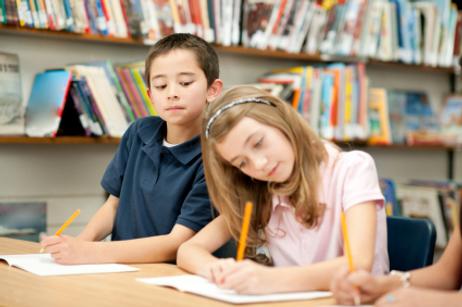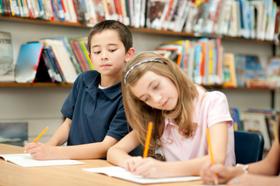Aided by technology, more students cheat in public schools than ever before. While only 20% of students in the 1940s admitted to cheating in school, this statistic has skyrocketed to 75% of today's high school student population, according to Educational Testing Service. From cell phones and text messages to emails, cheating has found technological accomplices.
Cheating Trends
According to the School Library Journal, Dr. Donald McCabe, a management and global business professor at Rutgers, has found that nearly all high school students have admitted to engaging in some form of cheating. Unbelievably, 95 percent of all of McCabe's surveyed students report that they have cheated (at some point) during their educational years! Whether the cheating involved copying homework, sharing answers on a test, or using other tactics, McCabe asserts that most teens participate in these behaviors - often without getting caught.
From surveying the cheating practices of high school students for over six years, McCabe has accumulated data from 24,000 high school students in 70,000 high schools. Based on this extensive data, McCabe found that 64 percent of the students have admitted to engaging in serious test-based cheating (including copying, helping someone during a test, and using hidden notes).
Why Students Cheat
Why do such a large majority of students cheat in school? While cheating was once stereotypically confined to struggling students, today's cheaters are often the "best" students. In fact, according to The Josephson Institute, "Cheating is higher among college-bound kids than any other group."
Other factors encourage cheating in public schools as well. As ABC News reports, students in today's public schools face high expectations and pressures. As a result, some students need to take advantage of academic shortcuts. According to student reflections, many steal material from other students, pass on materials from previous classes, or simply text answers to exams during and after class. Some students admit to cheating because their class grade is determined by a curve, which means that their own performance will impact how other students will be graded.
Still, other students admit that cheating is so prevalent that it seems insignificant to cheat academically.
The Technologies of Cheating
While cheating has most likely occurred since the beginning of the school system, modern technology is making these efforts far easier. Specifically, students admit that some of the most seemingly insignificant technologies are helping themselves (and their peers) cheat for higher grades.
- Graphing Calculators - Far from the standard and traditional calculators, graphing calculators are essentially hand-held computers. These tools can hold and store incredible amounts of information, including printed answers and/or notes for a test.
- Smart Phones - Advanced cellular phones with Internet access (such as a Blackberry or iPhone) enable students to send, store, and download information using the Internet and/or texting features.
- Basic Cell Phones - Even the most basic phones can pose a threat. Cell phones with cameras can be used to take pictures of assignments and/or test questions, and these pictures can then be sent to an unlimited number of students in a school.
- Apparel - Even though the technology is typically to blame for today's cheating strategies, some students cheat simply by using their clothing. Specifically, some students will write answers on their shoes (generally on the shoe's insole) and then peek at the notes by looking at their feet during an exam. Adding to this, some students have been known to scribble notes and answers to the inside rim of their hats. Lastly, even without the assistance of shoes or a hat, some kids have been caught writing answers on their arms while simply covering the notes with a long sleeve shirt. To access the notes, the student simply rolls up his or her sleeves while the teacher is not looking.
Fighting for Fairness: How Public School Leaders are Responding
With the growing prevalence of cheating, nearly all public schools have created updated policies and punishments to curb the cheating trend.
- Technology Restrictions - As iPods, cell phones, and other technology tools can be used for cheating, nearly all public schools are now enforcing strict cell phone and music policies. In fact, students caught with a cell phone or music device may even be subject to punishments ranging from suspension to a serious grade reduction.
- Clothing Restrictions - To avoid cheating involving hats and other hidden notes, most public school classrooms do not allow students to wear hats during tests. Additionally, many public schools reserve the right to ask a student to show his or her hands, forearms, and shoes if a teacher suspects a student of cheating.
- Re-setting Graphing Calculators - If a graphing calculator is required for a class or test, most public school teachers clear each student's calculator before major tests or assignments. This step removes students' saved data (along with any notes and copied answers) before and after the test.
- Plagiarism Tools - According to Dr. McCabe's studies, an estimated 58 percent of students surveyed have admitted to plagiarizing written work at least once. Plagiarizing involves using another student's work, copying and pasting information from the Internet, and intentionally not citing a source to make the writing look like the student's. To combat plagiarism, most public schools now require students to submit their writing online, allowing teachers to use software (such as Turn It In) to verify if the writing is copied from another student or an online resource.
- Additional Regulations - Some students have been caught using water bottles (with answers written on the label), backpacks, and even books to cheat during tests. Subsequently, many public schools no longer allow students to bring materials (including food and water) into a class during testing.
While cheating has risen dramatically in the last 50 years, school administrators are taking an aggressive stance toward cheaters. The regulations and awareness will hopefully help decrease the dramatic number of cheating instances in public schools.
Questions? Contact us on Twitter. @publicschoolreview












